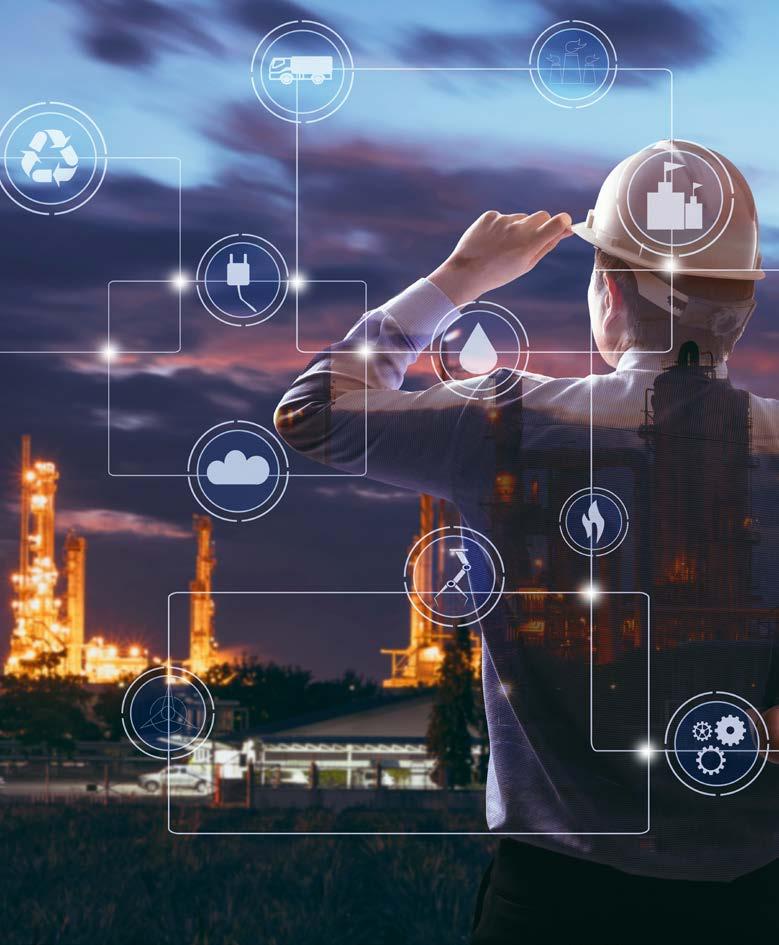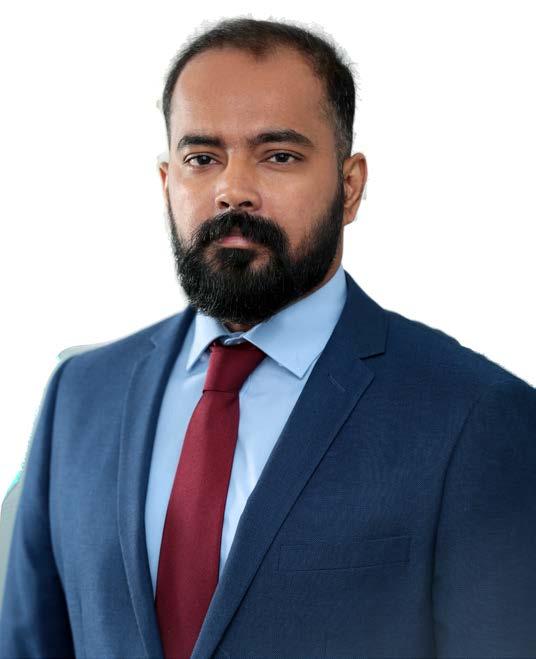
9 minute read
FUELLING SECURITY
AS THE OIL AND GAS SECTOR AND ITS SUPPLY CHAIN CONTINUE TO BUILD OUT DIGITALLY CONNECTED INFRASTRUCTURES, THEY FACE INCREASED CYBERSECURITY RISKS FROM BOTH EXTERNAL AND INTERNAL ACTORS. INDUSTRY EXPERTS DISCUSS THE CYBERSECURITY CHALLENGES THAT OIL AND GAS PROFESSIONALS SHOULD BE AWARE OF.
Several cyber breaches in the energy industry have hit the headlines, including tales of oil rigs riddled with malware or leaning heavily because they have become corrupted.
While some such stories have been distorted as they have spread online, there is no doubt that cybersecurity has become an increasing issue for the sector.
Indeed, a recent report from Deloitte, Protecting the Connected Barrels, stated that in 2016, energy was the second-mosttargeted industry in term of cyber-attacks.
Everyone from state-sponsored attackers through to ransomware fraudsters is looking to exploit vulnerabilities in the oil and gas industry.
“Most of the attacks we’ve seen have been to control the networks. It depends on who’s running it. A lot of Iranian or North Korean attacks have been destructive – to wipe out hard drives,” says Jonathan Couch, senior vice president for strategy at the cybersecurity company ThreatQuotient.
Few people have observed the oil and gas cybersecurity landscape in the Middle East more closely than Marcus Josefsson, the MEA sales director for Nozomi Networks.
He says that in this region, in particular, cyber-attacks affecting the energy industry tend to be more targeted – and often state-sponsored – than is typically the case in other parts of the world. The Iranian-backed Shamoon attack on the Saudi Arabian oil and gas company Aramco is one prominent example.
There are many motivations other than cyberwarfare, among them cyberespionage in the form of stealing field data, and financial gain, such as when ransomware is deployed.
Looking at the threats facing the sector’s operational technology (OT) and operational process vulnerabilities (as opposed to those targeting corporate networks), “criminal activity and ransomware impacts are on the rise and of growing concern,” according to Tim Conway, a technical director at the cybersecurity training organisation the SANS Institute.
“Criminal threat actors are typically taking advantage of opportunistic attacks due to poor access control protections, segmentation within the OT environments, remote access, and general lack of OT detection capability,” he says.
Threats are not all external, as they can come from inside companies, says Barak Perelman, the vice president of OT security at Tenable. There are disgruntled employees, third-party contractors and human error to consider.
Tim Conway, SANS Institute
“Whether the intention is malicious or purely accidental, it can have the same impact. For example, a contractor may plug a malware-infected PC into a remote site,” he says.
As well as disrupting operations, leading to financial losses, Deloitte’s report points out that attacks can threaten worker safety, particularly because of the cyberphysical dimensions of systems, harm a company’s reputation and cause environmental destruction if pollution results.
Given all of this, it is no wonder that, in recent years, cybersecurity has moved much higher up the agenda of the region’s energy companies.
“Every single large customer and medium-sized customer has projects in this space, and they wouldn’t be spending time and effort unless they were worried,” says Josefsson.
As well as having diverse origins, the vulnerabilities are varied too, ranging from upstream to downstream and everywhere in between.
Among upstream operations, development drilling and production tends to face greater cyber risks than another key activity, seismic imaging, but because the latter is now digitising, new vulnerabilities are set to be exposed in future.
“The most destructive attacks are upstream because you have much more risk in the physical dimension,” says Jean Abbal, strategic and channel partners manager for the MENA region at Nozomi Networks.
Abbal says that it is much more difficult to stop production upstream than it is downstream, where a suspension to allow things to recover is much easier.
Downstream there is, however, a wider range of potential threats, with “many different systems to optimise the chemical reactions,” as Abbal puts it.
“Everything is run by computers,” he says of downstream operations.
Pipelines too can be vulnerable to attacks that may, for example, attempt to increase the pressure of the oil passing through – with devastating consequences.
An incident as far back as 2008 in which a Turkish oil pipeline caught fire may, according to reports, have been caused by Russian attackers. They are suspected to have altered the pipeline’s pressure after hacking into computers at valve stations.
The barriers to dealing with threats are numerous, including that attack surfaces can be large and spread across a wide area, with remote operational sites. It may also be difficult to pinpoint attacks.
“In OT networks we have large security gaps because many don’t know which assets and devices are in the network,” says Tenable’s Perelman.
“And it’s one thing knowing about these devices and keeping an inventory – it’s a whole other thing to actually keep track of changes in configuration that alert you to risks and remediation taken.”
Perelman also notes that much of a network’s critical information is transferred using communications that are proprietary to the industrial vendors, be they Siemens, ABB, Honeywell, Rockwell or others.
“This makes standard IT monitoring tools blind to the most sensitive information in the network that requires analysis,” he says.
Another issue is that the priorities of those working with operational technology, which is typically focused primarily on safety, are often not the same as those who work in information technology, where cybersecurity is the key aim.
The oil and gas sector may be particularly vulnerable because, as ThreatQuotient’s Couch points out, there is widespread use of legacy technology. Indeed, he has dealt with companies still using Windows 95. Patching is often inadequate.
“A lot of it is driven by the consumer software as well as other regular commercial technology. It’s not up to date,” he says.
Perelman says that, when most industrial devices were designed and manufactured in the late 1980s and 1990s, “security wasn’t a top concern and cybersecurity wasn’t even a term”.
“Obviously those devices have many more vulnerabilities, and those are the same devices used in most industrial networks globally,” he says.
Many approaches are being taken to protect oil and gas companies from cybersecurity attacks. “IN OT NETWORKS WE HAVE LARGE SECURITY GAPS BECAUSE MANY DON’T KNOW WHICH ASSETS AND DEVICES ARE IN THE NETWORK.” Barak Perelman, Tenable
Perelman says that Tenable helps energy firms identify any threat that can disrupt their OT network by providing “a unified, risk-based view of IT and OT security”.
“This allows security teams to view and manage OT security issues alongside IT vulnerabilities, from assessment through closed-loop remediation verification,” he says.
He says that covering every target in both the IT and OT networks is important, including not just Windows PCs and servers, but also ICS devices, including industrial controllers.
“We recommend organisations ensure that they have the most productive and comprehensive alerts. This means monitoring both the network itself for traffic by connecting to a SPAN port, while also collecting information from the devices themselves for a complete picture,” he says.
The importance of developing the expertise of staff in ICS cybersecurity is emphasised by the SANS Institute, which provides education resources, training and validation for professionals responsible for defending OT environments in sectors including oil and gas. The organisation uses instructors who have real-world experience in the industry.
So, although the motivations of the attackers are numerous, and the vulnerabilities are many, there is plenty that energy companies can do and are doing to protect themselves. “THE MOST DESTRUCTIVE ATTACKS ARE UPSTREAM BECAUSE YOU HAVE MUCH MORE RISK IN THE PHYSICAL DIMENSION.” Jean Abbal, Nozomi Networks
WE’RE NOT JUST FIREWALLS.
SonicWall automated, real-time breach detection and prevention layers proven cybersecurity across your entire organization.
You know SonicWall because of our rich history designing high-performance firewalls. But like your organization, SonicWall has evolved.
Today, the modern SonicWall Capture Cloud Platform delivers automated, real-time breach detection and prevention to safeguard your business or organization.
With this layered approach, you can stop the most malicious cyberattacks, including ransomware and encrypted threats, from compromising your network and damaging your brand.
Physical & Virtual Firewalls
Multi-Engine Cloud Sandbox
Public & Private Cloud Security
Endpoint Protection

Secure Email
Cloud Application Security SD-WAN Web Application Firewall
Secure Remote & Wireless Access Unified Management & Reporting
www.SonicWall.com
Social icon Rounded square Only use blue and/or white. For more details check out our Brand Guidelines.
@SonicWall SonicWall SonicWall_Inc
ACCELERATING SECURITY

GOVIND HARIDAS, BUSINESS HEAD – CYBER SECURITY, HIPERDIST, SHARES INSIGHTS INTO THE LATEST CHALLENGES IMPACTING ENTERPRISES AND WHAT THE FUTURE HOLDS FOR THE SECURITY INDUSTRY.
What do you think will be the next ‘game-changing’ technology in the cybersecurity space? Artificial intelligence (AI) and machine learning are increasingly playing big roles in transforming multiple areas of IT and cybersecurity is no different. Therefore, we can expect to see more and more AI-driven cybersecurity solutions
What are the biggest cybersecurity challenges regional enterprises need to watch out for in 2020?
Phishing attacks, financial crimes, ransomware and lack of skilled resources are some of the primary challenges that enterprises need
to be wary of. Another issue that IT security leaders will also face is getting budgetary approvals for cybersecurity initiatives and investments due to the current economic conditions. Additionally, the recent coronavirus (COVID-19) pandemic has pushed many organisations to implement remote working schemes, which have increased their vulnerability to cyber-attacks.
Which disruptive technologies should organisations invest in to boost their cybersecurity strategies? AI-based machine learning, blockchain and IOT/OT security are the disruptive technologies that organisations should invest in to boost their cybersecurity strategies.
How will your offerings be instrumental in enabling organisations become cyber resilient? Our cybersecurity offerings focus on early detection, which is the key to becoming cyber resilient. Instead of
Govind Haridas, Hiperdist

focusing on protection solutions, our cyber portfolio has advanced tools which proactively detects threats before they disrupt the business operations.
What advice would you give organisations to ensure they succeed in their security transformation initiatives? We advise our customers to follow the best practices of cybersecurity. We focus on the critical controls that would give enhanced protections to our customer which ensures business continuity. Followed by providing them with next-gen disruptive technology controls to protect against sophisticated attacks.
How are you leveraging technologies around artificial intelligence and machine learning to enhance your offerings? Our digital marketing team already leverages an AI-based tool for lead generation and has churned out some fantastic results in a short timeframe. We are also in the final stages of signing up one of the leading AI vendors in the world whose offerings will be a game changer in the market.

How do you see global regulations around IT security evolving in the next few years? Hackers are becoming more sophisticated and organisations are increasingly adopting new and more complex technologies, which contribute to the expansion of the attack surface. I believe this will prompt increased global regulations around IT security, which are focused on data protection and cloud security.




